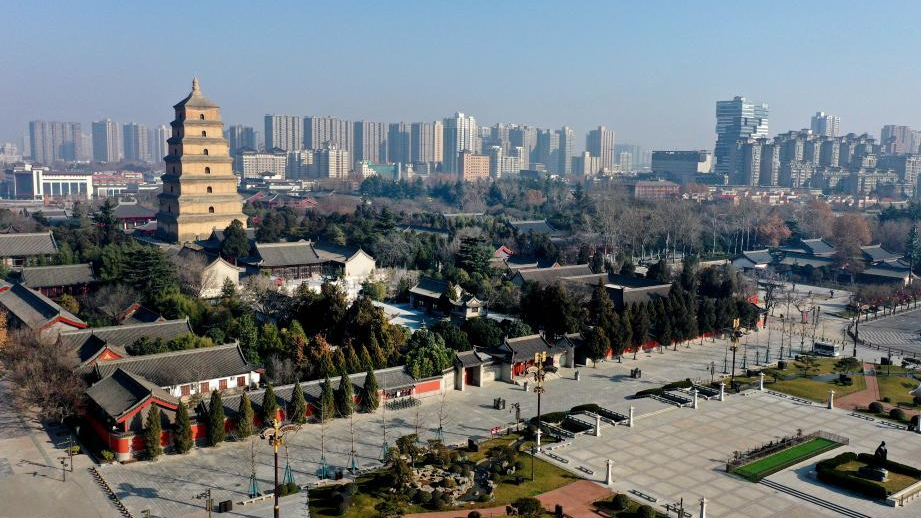
Xi'an, northwest China's Shaanxi Province, amid the COVID-19 pandemic, January 1, 2022. /Xinhua
Xi'an, northwest China's Shaanxi Province, amid the COVID-19 pandemic, January 1, 2022. /Xinhua
Editor's note: C. Saratchand is a professor at the Department of Economics, Satyawati College at the University of Delhi in India.The article reflects the author's opinions and not necessarily those of CGTN.
The policy strategy to be adopted to deal with the COVID-19 pandemic has gone through several iterations depending on the policy instruments available. The policy instruments currently available to deal with the COVID-19 pandemic include vaccinations, testing, and pharmaceutical and non-pharmaceutical intervention.
Currently, it is materially feasible for many governments to either stimulate the production or import of vaccine doses, test kits and materials required for pharmaceutical interventions. All governments can gather the resources or aid to support non-pharmaceutical intervention if they put in place appropriate complementary policies.
The policy strategies currently employed in tackling the COVID-19 pandemic may be broadly classified into two: "living with COVID-19" and "dynamic zero-COVID-19." The "living with COVID-19" strategy involves the government accepting a certain range of infection rates and deaths from COVID-19 in the population. This "acceptable" range may vary across countries where this strategy is adopted. As long as infections and deaths from COVID-19 are within this "acceptable" range, the government does not emphasize testing and non-pharmaceutical intervention.
However, the "living with COVID-19" strategy contradicts the laws that determine how epidemics proliferate. Let us set out these laws briefly in a non-technical manner.
Once testing is available, there will be at least four categories in a population that is affected by COVID-19: susceptible to infection, infected, quarantined or under treatment and recovered from infection. Some people who are infected may die. A person whose infection is detected through testing and survives will traverse through all four categories.
As far as COVID-19 is concerned, since immunity acquired through vaccination or past infection is not permanent, some people will always transit from the category of recovered to once again becoming susceptible. However, vaccination does reduce the likelihood of death and severe disease.
This may be due to two reasons. First, all immunity, whether through surviving past infection or COVID-19 vaccination, is not permanent because viruses such as SARS-CoV-2 mutate continuously. Newer virus variants may be more transmissible, possibly evading existing vaccines, or more virulent with a greater mortality or hospitalization rate or both. "Living with COVID-19" is an open invitation for SARS-Cov-2 to mutate unless one contracts a benign variant by chance, one with no mortality, low hospitalization or contained by existing vaccines.
For "living with COVID-19" to be an optimal strategy, this benign variant must rapidly infect a sufficiently large number of people and confer immunity against future variants of the virus. The conjunction of all these chance factors is quite unlikely in the foreseeable future and cannot constitute a basis for rational policymaking.
"Living with COVID-19," despite being epidemiologically unscientific, is upheld by some policymakers since "living with COVID-19" has ostensibly lower economic costs. However, if there are repeated waves of infection resurgence and deaths requiring non-pharmaceutical interventions, such as full or partial lockdowns and repeated booster doses of the vaccine, then the cumulative economic cost from "living with COVID-19" may exceed that of an alternative strategy.
Further, a fundamental objection to the "living with COVID-19" strategy is that some people will keep dying from it. All those who advocate for the "living with COVID-19" strategy are explicitly or implicitly imputing a finite economic value to each life and therefore are "willing" to let a certain number of people die to "keep the economy going" and to "preserve freedoms."
Since the first argument is not necessarily valid for the aforementioned reasons, let us consider the second argument. "Preserving freedoms" is only a euphemism for an attempt to manufacture consent among the deprived about why the state cannot mobilize the resources from the elite to try and protect the lives and livelihoods of the deprived. Elites are wary about the possibility of such support measures persisting after the end of the pandemic.
Further, elites are chary that the solidarity that inheres in effectively combating the pandemic may impose fetters on their ability to determine the contours of policymaking in the future. In other words, elites tend to further a "living with COVID-19" strategy since it is more conducive to their long-term private interests even if it damages these very same private interests in the short term.
The "dynamic zero-COVID-19" strategy is the principal alternative to "living with COVID-19." A "dynamic zero-COVID-19" strategy involves an attempt to control and eliminate every incidence of COVID-19 infection.

People wait in a COVID-19 testing line in Midtown during the first snow storm of the season in New York City, U.S., January 7, 2022. /Getty
People wait in a COVID-19 testing line in Midtown during the first snow storm of the season in New York City, U.S., January 7, 2022. /Getty
First, the country's government regulates the entry and exit of non-residents to prevent transmission of infections from outside.
Second, if there is an outbreak, there is a localized lockdown followed by free and universal testing. All those infected in the cluster are institutionally treated free of cost. During this localized lockdown, essential needs such as food and healthcare are met through a dedicated and trained team of activists.
Third, the solidarity inherent in such a strategy is conducive to universal masking and universal and free vaccination. As a result, outbreaks are quickly controlled, and the duration of localized lockdowns is relatively short. Most importantly, the number of deaths is either very low or zero.
Moreover, such a "dynamic zero-COVID-19" strategy is likely to involve lower economic costs relative to a "living with COVID-19" strategy.
Further, the "dynamic zero-COVID-19" strategy by rapidly eliminating infections prevents the rise of new variants that may prolong the pandemic. In others words, the "dynamic zero-COVID-19" strategy is socially optimal.
The economic cost and social consequences of a "dynamic zero-COVID-19" strategy in a country will depend on what COVID-19 mitigation strategy is adopted in other countries of the world. For instance, if the rest of the world were adopting a "living with COVID-19" strategy, then the country with a "dynamic zero-COVID-19" strategy would have to institute a relatively more rigorous regulation of non-resident entry and exit.
How can the "dynamic zero COVID-19" strategy be extended to the whole world? At one level, each country's government would need to adopt a "dynamic zero-COVID-19" strategy. But international coordination and solidarity would be needed to sustain it. Since every country in the world cannot import vaccines, masks, test kits, public health equipment and materials, etc., the production and distribution of these materials would need to be augmented compared to their current levels.
A quick way to do this is for developed countries to share knowledge about vaccine production with countries like China and India that have large vaccine production capacities. Then developed countries could bear a part or the whole of the cost of production and dissemination of both these vaccines and gain access to locally produced vaccines in China, India, etc. Similar effective funding commitments are required to finance the production and distribution of masks, test kits and other public health equipment and materials.
Non-pharmaceutical intervention would need to be supported through complementary economic support measures. This increase in public expenditure could be financed by a small tax on international financial speculation. If the measures above are adopted, it would be possible to quickly eliminate morbidity and mortality due to COVID-19.
Second, the creation of newer variants of SARS-CoV-2 can be arrested. For each country and the world as a whole, the economic cost of a global "dynamic zero-COVID-19" strategy would tend to be lower than if only some countries adopted a "dynamic zero-COVID-19" strategy. Further, at the macroeconomic level, equivalent increases in public expenditure and taxation will leave the magnitude of aggregate profits unchanged.
Also, if the increase in public health materials and equipment production and the absence of a need to institute periodic non-pharmaceutical interventions increase capacity utilization, the resulting investment rise would increase aggregate profits.
A global "dynamic zero-COVID-19" strategy is the sole feasible and socially optimal strategy to immediately deal with the COVID-19 pandemic. However, it is arguable that if pharmaceutical interventions that make morbidity, especially mortality from COVID-19, vanishingly small, were to emerge and could be quickly adapted to deal with new variants, then a refurbished "living with COVID-19" may become optimal.
However, this will be socially optimal only if these pharmaceutical interventions are universally and freely available. At present, this option does not exist. Therefore, any delay in adopting a global "dynamic zero-COVID-19" strategy to wait until the aforementioned option becomes available, inter alia "preserving freedoms," is equivalent to the countenancing of avoidable morbidity and mortality. This avoidable morbidity and mortality will also disproportionately impact the deprived sections of the people.
A worldwide "dynamic zero-COVID-19" strategy will not only effectively tackle the COVID-19 pandemic but may also be a prelude to a constructive change in the dynamics of the international political economy.
(If you want to contribute and have specific expertise, please contact us at opinions@cgtn.com.)

